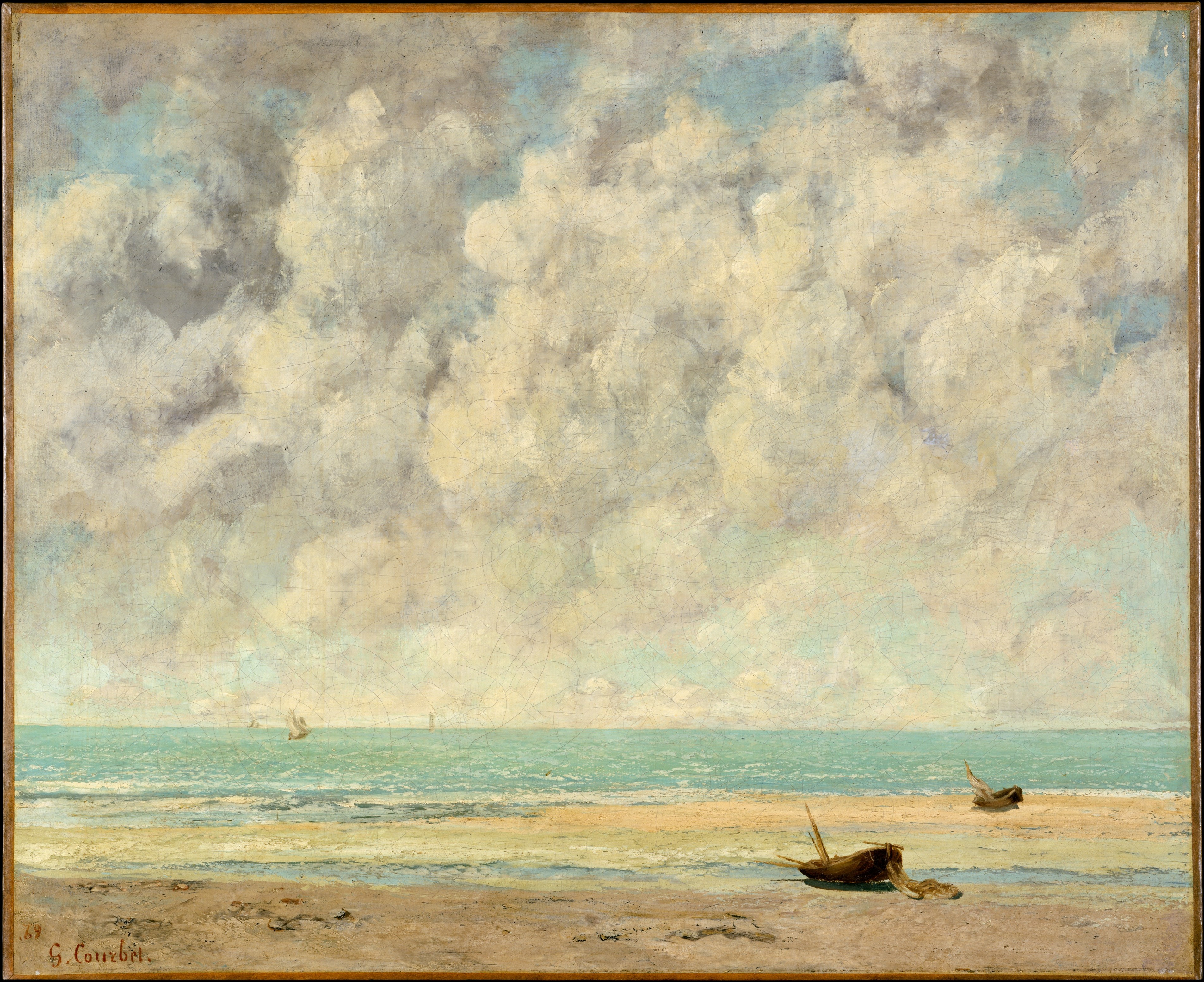Visiting Sleeping Beauties: Reawakening Fashion?
You must join the virtual exhibition queue when you arrive. If capacity has been reached for the day, the queue will close early.
Learn more
Jump to content tickets Member | Make a donation
- The Collection
- The American Wing Ancient Near Eastern Art Arms and Armor The Michael C. Rockefeller Wing Asian Art The Cloisters The Costume Institute Drawings and Prints Egyptian Art European Paintings European Sculpture and Decorative Arts Greek and Roman Art Islamic Art Robert Lehman Collection The Libraries Medieval Art Musical Instruments Photographs Antonio Ratti Textile Center Modern and Contemporary Art
Crop your artwork:
Scan your QR code:
Gratefully built with ACNLPatternTool
Gustave Courbet French
On view at The Met Fifth Avenue in Gallery 812
Courbet painted this view looking out over the English Channel during a visit to Étretat along the coast of Normandy in August 1869. The ocean has receded at low tide, and two small boats are left on the shore. The tranquil composition, with its immense sky towering over narrow bands of water and sand, is unusual for Courbet’s marine paintings of this period, dominated by dramatically crashing waves.
Open Access
As part of the Met's Open Access policy, you can freely copy, modify and distribute this image, even for commercial purposes.
API
Public domain data for this object can also be accessed using the Met's Open Access API.
- Download image
Artwork Details
Use your arrow keys to navigate the tabs below, and your tab key to choose an item
Title: The Calm Sea
Artist: Gustave Courbet (French, Ornans 1819–1877 La Tour-de-Peilz)
Date: 1869
Medium: Oil on canvas
Dimensions: 23 1/2 x 28 3/4 in. (59.7 x 73 cm)
Classification: Paintings
Credit Line: H. O. Havemeyer Collection, Bequest of Mrs. H. O. Havemeyer, 1929
Accession Number: 29.100.566
Learn more about this artwork
Timeline of Art History
Essay
Gustave Courbet (1819-1877)
Chronology
France, 1800-1900 A.D.
Museum Publications
The Metropolitan Museum of Art. Vol. 7, Europe in the Age of Enlightenment and Revolution
Splendid Legacy: The Havemeyer Collection
Origins of Impressionism
Masterpieces of European Painting, 1800–1920, in The Metropolitan Museum of Art
French Paintings: A Catalogue of the Collection of The Metropolitan Museum of Art. Vol. 2, Nineteenth Century
European Paintings in The Metropolitan Museum of Art by Artists Born before 1865: A Summary Catalogue
A Concise Catalogue of the European Paintings in the Metropolitan Museum of Art
Related Artworks
- All Related Artworks
- In the same gallery
- By Gustave Courbet
- European Paintings
- Canvas
- Oil paint
- Paintings
- From Europe
- From France
- From A.D. 1800–1900
A Brook in the Forest
Gustave Courbet (French, Ornans 1819–1877 La Tour-de-Peilz)
ca. 1868–77
Self-Portrait
Gustave Courbet (French, Ornans 1819–1877 La Tour-de-Peilz)
ca. 1866
The Homecoming
Gustave Courbet (French, Ornans 1819–1877 La Tour-de-Peilz)
ca. 1854
A Brook in a Clearing (possibly "Brook, Valley of Fontcouverte; Study")
Gustave Courbet (French, Ornans 1819–1877 La Tour-de-Peilz)
probably 1862
The Hidden Brook
Gustave Courbet (French, Ornans 1819–1877 La Tour-de-Peilz)
ca. 1873–77
Resources for Research
The Met's Libraries and Research Centers provide unparalleled resources for research and welcome an international community of students and scholars.
The Met Collection API is where all makers, creators, researchers, and dreamers can connect to the most up-to-date data and public domain images for The Met collection. Open Access data and public domain images are available for unrestricted commercial and noncommercial use without permission or fee.
Feedback
We continue to research and examine historical and cultural context for objects in The Met collection. If you have comments or questions about this object record, please complete and submit this form. The Museum looks forward to receiving your comments.
European Paintings at The Met
The Met's celebrated European Paintings collection encompasses more than 2,500 works of art from the thirteenth through the early twentieth century.
